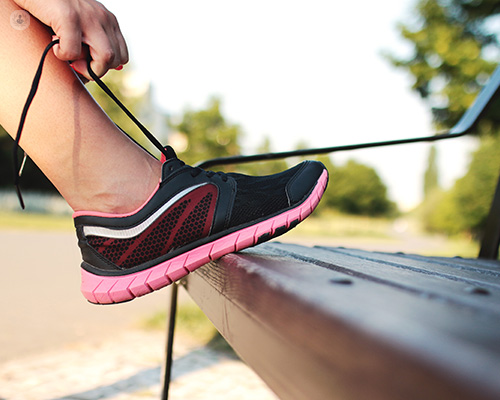How is Achilles tendonitis treated?
Written by:Heel pain will affect most of us at some point in our lives, but what happens if that pain doesn’t go away, or occurs frequently? Many conditions cause heel pain – one such condition is Achilles tendonitis, which causes pain, stiffness, and swelling of the Achilles tendon. It is one of the most common conditions affecting the foot, but it can be difficult to spot at first, as the resulting pain and stiffness can develop over time, rather than suddenly. Expert orthopaedic surgeon Mr Krishna Vemulapalli explains how to spot the symptoms of Achilles tendonitis, and how the condition can be treated.

What is Achilles tendonitis?
Your Achilles tendon is the thickest and strongest tendon in the human body, found at the back of the leg. It connects various muscles (the plantaris, the gastrocnemius, and soleus muscles) to the heel bone. The Achilles tendon pulls on the heel when the muscles in your calf flex – nearly every activity we do involving moving our feet puts the Achilles tendon into use. It allows us to stand on our tiptoes, and helps us run and jump. Even though the Achilles tendon is so strong, it is vulnerable to injury because of the tension it is regularly put under.
There are many different types of tendonitis, but it is a general term referring to a tendon swelling up and becoming painful, usually after the tendon is injured in some way. Therefore, Achilles tendonitis is an inflammation of the Achilles tendon, and it usually occurs as a result of frequent activity putting the tendon under strain.
While athletes more commonly experience the condition, it can affect anyone, and it can also be caused by other conditions such as psoriatic arthritis, and ankylosing spondylitis.
What are the symptoms of Achilles tendonitis?
Achilles tendonitis often begins as a burning pain, felt when first starting an activity (e.g running), which then lessens during the activity, and is felt again once the activity is stopped. Usually the burning worsens after the activity is over. Pain and stiffness may be felt the morning after the activity or exercise session.
Other symptoms to watch for include:
- Swelling or a lump around the Achilles tendon, which may also be tender
- Redness and warmth in the area, which occurs due to inflammation
- Pain which gets worse when the Achilles tendon is put into use
- Weakness in the tendon
- Difficulty moving the Achilles tendon
- Hearing a crackling/crunching sound when moving the tendon, or experiencing a crackling sensation when moving it
- Start/up pain as well as early morning pain
How is Achilles tendonitis treated?
After tendonitis is diagnosed, it is usually treated at home initially using the RICE method, which refers to rest, ice, compression, and elevation. The Achilles tendon must be allowed to rest for a period, without weight put on it, so some of the pressure can be relieved. Ice helps to control pain, and ice packs can be applied for periods of 10-30 minutes at a time. Compression (wrapping a bandage around the injury) provides support, and elevation helps to reduce blood flow to the affected area, meaning swelling and inflammation is minimised. Over-the-counter medication can be taken to help with mild pain relief.
Once you can move the injury without it being painful, try to keep moving so the tendon does not become stiff. Physiotherapy can help you to build your Achilles tendon strength and restore it to full capacity.
Surgery is not the first line of treatment for Achilles tendonitis - however, if the symptoms go on for months, and all treatment routes have been attempted, an orthopaedic surgeon may be consulted, particularly if the pain is affecting you greatly in your day to day life. The tendon may have ruptured, requiring restorative surgery.
Is there any way to prevent Achilles tendonitis?
Most tendon injuries are caused through gradual wearing down of the tendon, as a result of overuse or ageing. While anyone can have a tendon injury, those most commonly affected are athletes or those who do the same repetitive movements over and over. Some common causes of Achilles tendonitis include:
- Exercising after a long ‘down time’ – meaning the tendon is out of use
- A sudden change in training activity, such as increasing intensity
- Poor technique
- Walking on the toes, or prolonged wearing of high heels
- Footwear not offering the right support
- Running in hilly or mountainous environments
- An abrupt change in training surface, such as moving from astroturf to grass
Therefore, if you practise sports, it is essential to protect the Achilles tendon and take care not to strain it wherever possible. Wear appropriate footwear, be aware of how you train, and ease yourself into training if you are out of practice. Make sure to warm up before commencing exercise, and stretch afterwards. If the exercise or activity you are doing is repetitive, take regular breaks.


